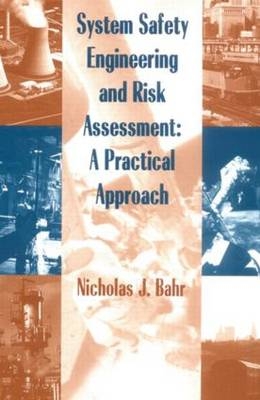
System Safety Engineering And Risk Assessment
Taylor & Francis Inc (Verlag)
978-1-56032-416-4 (ISBN)
- Titel erscheint in neuer Auflage
- Artikel merken
As technological systems become more complex, it becomes increasingly difficult to identify safety hazards and to control their impact. Engineers today are finding that safety and risk touch upon every aspect of any engineered process, from system design all the way through disposal. Employing highly pragmatic examples from a number of industries, System Safety Engineering and Risk Assessment: A Practical Approach provides a comprehensive and easily accessible guide on how to build safety into products as well as into industrial processes.
Using a systems approach, the text discusses the best system safety techniques used in various industries, types of hazard analyses, safety checklists and other safety tools, as well as techniques for investigating accidents. It explains how to set up a data management system for a system safety program, and delves into risk assessment, including ways to conduct a risk evaluation. While the book provides engineers with an efficient reference in a critical area, the clarity of the writing along with the case studies and illustrations makes this book accessible to non-technical professionals needing a how to guide for the safety management of complex systems. It is also used by graduate classes involved with ergonomics and occupational safety as well as engineering.
INTRODUCTION
Why Do We Need Safety Engineering? What Is Safety Analysis? System Safety and Risk Assessment. A Brief History of Safety
DEFINITIONS AND CONCEPTS
The Make-up of an Accident. How Safe Is Safe Enough? What Is a Hazard and Other Important Concepts. The System Safety Process. Hazard Identification. Hazard Control. Risk Acceptance. Hazard Reduction Precedence. "Design out" the Hazard. Safety Devices. Warning Devices. Special Procedures and Training. The Use of Standards in Safety. U.S. Government Standards. U.S. Industry Standards. International Standards.
SAFETY ANALYSIS IN ENGINEERING--HOW IS IT USED?
The Manufacturing Industry. The Chemical Process Industry. Aerospace and Military Industries. The Nuclear Power Industry. The Mass Transit Industry
SAFETY MANAGEMENT
Safety in the System Life Cycle. System Life Cycle. Safety and the System Life Cycle. Examples of Poor Application of Safety in the System Life Cycle. Organizational Management and Safety. Management Commitment. Suggested Ideas to Enhance Management Involvement. The System Safety Organization. Developing a System Safety Program. Elements of a System Safety Program. Setting up a System Safety Program. Evaluating Contractors and Subcontractors. Emergency Preparedness Programs. Common Mistakes in Implementing Safety Programs. A Closed-Loop Process. Hazard Tracking and Resolution. System Safety Reviews and Audits. Voluntary Protection Programs.
HAZARD ANALYSIS
Hazard Analysis Methodology. Preliminary Hazard List. Passenger-Carrying Submersible Example. Hazard Analysis--Preliminary, Subsystem, and System. Facility Hazard Analysis. Operations and Support Hazard Analysis. Examples of Hazard Analyses. Example Hazard Analysis of NASA Laser. Brief Example of a Hazardous Waste Storage Facility Hazard Analysis.
PROCESS SAFETY ANALYSIS
Process Hazard Analysis. HAZOP. "What If?" Analysis and Safety Checklists. Brief HAZOP Example of an Ammonia Fill Station. Example "What If?" Safety Checklist for Pressure Test Equipment.
FAULT TREE ANALYSIS
Fault Tree Symbols and Logic. Finding Cut Sets. Fault Tree Quantification. Example of a Fault Tree Construction of a Motor-Pump Pressure System. Common Mistakes in Fault Trees.
FMECA, HUMAN FACTORS, AND SOFTWARE SAFETY
Failure Modes, Effects, and Criticality Analysis. Conducting a Failure Modes and Effects Analysis. Failure Modes, Effects, and Criticality Analysis. Human Factors Safety Analysis. Performance and Human Error. Human Factors Safety Analysis. Brief Example of Human Factors Safety Analysis--Manual Switchover to Auxiliary Feedwater System. Software Safety. Software Safety Analysis. Software Testing and IV & V.
OTHER TECHNIQUES
MORT. Energy Trace Barrier Analysis. Sneak Circuit Analysis. Cause-Consequence Analysis. Dispersion Modeling. Test Safety. Comparing the Various Techniques. Advantages and Disadvantages
DATA SOURCES AND TRAINING
Government Data Banks. Industry Data Banks. Creating Your Own Data Bank--Some Suggestions. Safety Training. Employee Training. Emergency Preparedness and Response Training. Personnel Certification for Hazardous Operations. Sample Safety Training Course Outline for a Microprocessor Production Plant. Safety Awareness.
ACCIDENT REPORTING, INVESTIGATION, AND DOCUMENTATION
Reporting the Accident. Setting up a Closed-Loop Reporting System. Example of an Automated System. Forming an Investigation Board. Selecting the Investigation Board. Conducting the Investigation. Investigation Report. Documenting the Accident. Retention of Records. Public Release of Information
RISK ASSESSMENT
What Is Risk? Risk Perception. Risk Assessment Methodology. Identifying Risk in a System. Risk Communication.
RISK EVALUATION
. A Probabilistic Approach. A Risk Analysis Model. Developing Accident Scenarios and Initiating Events. Event Trees. Consequences Determination. Uncertainty. Risk Evaluation--The Use of Risk Profiles. Calculating Safety Costs. Brief Example: Risk Assessment of Launching a Space Shuttle Payload
APPENDICES
Typical Energy Sources; Generic Hazard Checklist; Generic Facility Safety Checklist; Internet Sources
References and suggested reading recommendations follow most chapter.
| Erscheint lt. Verlag | 1.9.1997 |
|---|---|
| Verlagsort | Washington |
| Sprache | englisch |
| Maße | 156 x 234 mm |
| Gewicht | 499 g |
| Themenwelt | Technik ► Maschinenbau |
| Wirtschaft | |
| ISBN-10 | 1-56032-416-3 / 1560324163 |
| ISBN-13 | 978-1-56032-416-4 / 9781560324164 |
| Zustand | Neuware |
| Haben Sie eine Frage zum Produkt? |
aus dem Bereich



